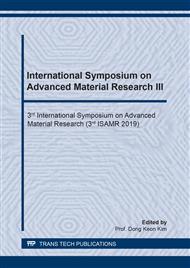[1]
S. Vaidya, P. Rathore, Isolation, Screening and Characterization of Amylase Producing Bacteria from Soil of Potato Dump Sites from Different Regions of Madhya Pradesh, Int. Conf. Recent Trends Agri. Veterinary Life Sci. (2015) 1-7.
Google Scholar
[2]
A. S. Azmi, G. C. Ngoh, M. Mel, M. Hasan, Ragi tapai and Saccharomyces cerevisiae as potential coculture in viscous fermentation medium for ethanol production, African J. Biotechnol. 9(42) (2010) 7122-7127.
Google Scholar
[3]
L. Gandjar, Tapai from cassave and cereals. In Proceedings of the 1st International symposium and workshop on insight into the world of indigenous fermented foods for technology development and food safety (IWIFF), Bangkok, Thailand, (2003) 152-157.
Google Scholar
[4]
T. Barus, A. Kristani, A. Yulandi, Diversity of Amylase-Producing Bacillus spp. from Tape, (Fermented Cassava), HAYATI J. Biosci. 20 (2013) 94-98.
DOI: 10.4308/hjb.20.2.94
Google Scholar
[5]
C. W. Hesseltine, C. P. Kurtzman, Yeasts in Amylolytic Food Starters. Anales del Instituto de Biología. Serie Botánica, 60(1) (1990) 1-7.
Google Scholar
[6]
B. K. Lonsane, M. V. Ramesh, Production of Bacterial Thermostable α-Amylase by Solid-State Fermentation: A Potential Tool for Achieving Economy in Enzyme Production and Starch Hydrolysis, in S. L. Neidleman & A. I. Laskin (Eds.), Adv. Appl. Microbiol. Academic Press, 35 (1990) 1-56.
DOI: 10.1016/s0065-2164(08)70242-9
Google Scholar
[7]
D. Divakaran, A. Chandran, P. Chandran, Comparative Study On Production Of Α-Amylase From Bacillus licheniformis Strains, Brazilian J. Microbiol. 42 (2011) 1397-1404.
DOI: 10.1590/s1517-83822011000400022
Google Scholar
[8]
M. M. Hasan, L. W. Marzan, A. Hosna, A. Hakim, A. K. Azad, Optimization of some fermentation conditions for the production of extraxellular amylases by using Chryseobacterium and Bacillus isolates from organis kitchen wastes, J. Genetic Eng. Biotechnol. 15 (2017) 59-68.
DOI: 10.1016/j.jgeb.2017.02.009
Google Scholar
[9]
S. Ishmayana, D. S. Kamara, S. D. Rachman, I. Kardi, M. Fadhlillah, Amylase production from the yeast Saccharomycopsis fibuligera and its potency for glucose production from raw starch, Proceeding of The International Seminar on Chemistry, (2008) 688-691.
Google Scholar
[10]
O. Kunle, Y. Ibrahim, M. Emeje, S.Shaba, Y. Kunle, Extraction, Physicochemical and Compaction Properties of Tacca Starch-a Potential Pharmaceutical Excipient, Starch-Starke, 55 (2003) 319-325.
DOI: 10.1002/star.200390067
Google Scholar
[11]
Q. T. Vu, P. T. Le, H. P. Vo, T. Thanh, T. K. Nguyen, Characteristics of Tacca leontopetaloides L. Kuntze Collected from An Giang in Vietnam. AIP Conference Proceedings, (2017) 020022-1–020022-6.
DOI: 10.1063/1.5000190
Google Scholar
[12]
E. Gomes, S. Regina de Souza, R. P. Grandi, R. Da Silva, Production of thermostable glucoamylase by newly isolated Aspergillus flavus A 1.1 and Thermomyces lanuginosus A 13.37, Brazilian J. Microbiol. 36(1) (2005) 75-82.
DOI: 10.1590/s1517-83822005000100015
Google Scholar
[13]
S. Bano, S. A. Ul Qader, A. Aman, M. N. Syed, A. Azhar, Purification and Characterization of Novel α-Amylase from Bacillus subtilis KIBGE HAS, AAPS Pharm. Sci. Tech. 12 (2011) 255-261.
DOI: 10.1208/s12249-011-9586-1
Google Scholar
[14]
A. K. Sharma, V. Sharma, J. Saxena, R. Chandra, A. Alam, A. Prakash, Isolation and Screening of Amylolytic Bacteria from Soil, Int. J. Scientific Res. Agri. Sci. 2(7) (2015) 159-165.
DOI: 10.12983/ijsras-2015-p0159-0165
Google Scholar
[15]
P. Deb, S. A. Talukdar, K. Mohsina, P. K. Sarker, S. M. Abu Sayem, Production and partial characterization of extracellular amylase enzyme from Bacillus amyloliquefaciens P-001, Springer Plus, 2 (2013) 154.
DOI: 10.1186/2193-1801-2-154
Google Scholar
[16]
T. Barus, L. N. Wijaya, Dominant Microbiota and Their Role in Flavor of Cassava Tape, Biota. 2 (2011) 354-361.
Google Scholar
[17]
S. C. B. Gopinath, A. Hilda, T. Lakshmi Priya, G. Annadurai, P. Anbu, Purification of lipase from Geotrichum candidum: conditions optimized for enzyme production using Box-Behnken design, World Journal of Microbiology and Biotechnology, 19(2003), 681–689.
DOI: 10.1023/a:1025119222925
Google Scholar
[18]
Y. W. Chiang, F. Y. Chue, A. Mohd Ismail, Microbial Diversity and Proximate Composition of Tapai, a Sabah's Fermented Beverage, Malaysian J. Microbiol. (2006) 1-6.
DOI: 10.21161/mjm.210601
Google Scholar
[19]
A. A. Simair, A. S. Qureshi, I. Khushk, C. H. Ali, S. Lashari, M. A. Bhutto, G. S. Mangrio, C. Lu., Production and Partial Characterization of α-Amylase Enzyme from Bacillus sp. BCC 01-50 and Potential Applications, Bio. Med. Res. Int. 2017 (2017) 1-9.
DOI: 10.1155/2017/9173040
Google Scholar
[20]
M. J. Syu, Y. H. Chen, A Study On The Α-Amylase Fermentation Performed By Bacillus Amyloliquefaciens, Chem. Eng. J. 65 (1997) 237-247.
DOI: 10.1016/s1385-8947(97)00020-x
Google Scholar
[21]
F. Elegado, Y. Fujio, Selection of raw starch digestive glucoamylase producing Rhizopus strain. Journal Gen Appl Microbiol. (1993) 540-546.
DOI: 10.2323/jgam.39.541
Google Scholar
[22]
A. Ghose, B. Chatterjnee, A.Das, Characterization of glucoamylas from Aspergillus terres 4. FEMS Microbiol. (1990) 345-350.
Google Scholar
[23]
M. Omojola, Tacca Starch: a Review of its Production, Physiochemical Properties, Modification and Industrial Uses. African Journal of Foods, Agriculture, Nutrition and Development, (2013) 7972-7985.
DOI: 10.18697/ajfand.59.12930
Google Scholar


